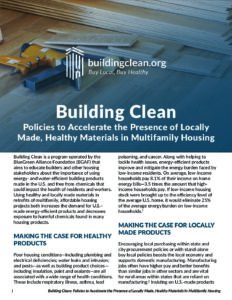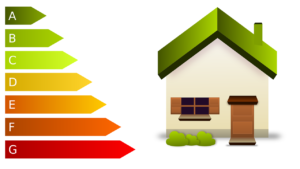Biophilic Design as a Holistic Approach to Healthier Buildings
Biophilic design is the practice of connecting people and nature within our built environments and communities. It prioritizes integrating innovative building materials and techniques into living spaces that are beneficial to our health. People spend around 90% of their time indoors, implying that public health highly depends on the health of indoor ecosystems. Relative to affordable housing, biophilic design provides a path forward for healthier and more beautiful spaces, and has the potential to rectify the negative impacts of living in what are too often depleted and insufficient living environments.
Biophilic design exemplifies the notion that spaces should be cultivated for enhancing public health and nurturing humans’ innate desire to feel connected to natural systems. In buildings, incorporating environmental features such as natural ventilation and daylight, views and vistas, green walls and flora, or access to a garden provides occupants with a direct visual and experiential connection to nature. Integrating organic shapes and forms such as tree-like columns, botanical motifs, and spirals into design is another effective way of evoking nature.1 Projects that draw inspiration from surrounding geography, history, ecology, and culture create an environment for occupants to experience a sense of belonging in having their unique community reflected in their dwelling spaces.
The building materials that comprise our living spaces have the ability to affect cognitive functionality and performance, psychological health, physiological health, and our overall well-being. Indoor air is often polluted by building and consumer products containing hazardous chemicals, including Volatile Organic Compounds (VOCs), which can cause long-term damage to the liver, kidney, and central nervous system.2 Respiratory ailments, prohibitive proper cognitive development, high stress levels, high blood pressure, toxic legacies, depression, anxiety, and cancer can be developed or exacerbated if our built environment does not create a positive nurturing habitat that acknowledges people as biological entities.3
A visual connection to nature curated with the power of healthier building products and design strategy can have a positive impact on attention restoration, stress reduction, and overall health and well-being. Studies have shown that biophilic indoor environments correlate with increased cognitive function, reduced stress and anxiety responses, and an increase in positive emotions as compared with those in non-biophilic environments.4 This has been demonstrated in certain studies, which showed that bright sunlit rooms resulted in a 26-41% reduction in the length of a hospital stay,5 and a 10-15% increased mental function and memory recall when given access to a view.6 In addition to the positive effects on mental health, biophilic design frameworks can contribute to cleaner indoor air quality through increased ventilation and fewer toxicants in building materials. It is shown that when schools upgraded to displacement ventilation to increase fresh air, occupants benefited from a 69% reduction in asthma.7 Additionally, when people had access to natural ventilation a 16.7% reduction in doctor visits was shown.8
Healthier building materials aid in the implementation of biophilic design in a space through multiple facets. Light, air, natural ventilation, sounds, texture, colors, and materials all provide opportunities for building products to embody characteristics of the natural environment. Incorporating minimally processed organic materials such as cork, compressed earth, or clay and lime paints and plasters–into our interior spaces provide residents a visual and tactile connection to nature while also benefiting from low- to zero- VOC building products. Emerging biomaterial markets and products are promising the adoption of more natural materials in our dwelling spaces. Cross laminated timber (CLT) and mass timber–which consist of wooden planks glued together to form structural walls, floors, and beams–offer positive benefits to building occupants in connecting them to exposed wood grain, while contributing to climate resiliency with its inherent carbon-storing properties.9 Additionally, the rise in research and production of 3-D printed homes could expand the possibilities of incorporating organic shapes and non-linear spaces into our buildings, providing new frontiers for biophilic design in homes, schools, hospitals, and retail spaces.
Green building certifications can play a vital role in contributing to the creation of healthier and biophilic spaces. A renewed interest and a growing path to resource conserving biophilic buildings has been led by the International Living Future Institute and their Living Building Challenge (LBC). In their “deep green” building certification, they require that design and build teams incorporate biophilic design strategies into building projects by looking to their local ecology, climate, and culture for inspiration. Project teams seeking LBC Certification must participate in a day long workshop dedicated to exploring the potential for biophilic design for their projects, and must result in a framework and plan for addressing how projects will integrate place-based relationships, public art, nature-inspired patterns, and environmental features.10 WELL Certification, a green building certification focusing on health and wellness in the built environment rewards points for a variety of biophilic design features outlined in their building standard, including occupant access to nature; deliberate restorative spaces; nutrition education; proximity to local food production; and circadian lighting design.11
Strategies that uphold equity and fairness should be at the heart of affordable housing, and biophilic design frameworks have the potential to guide building design and construction into spaces that promote occupant and community health.12 By looking to green building certifications such as Living Building Challenge and WELL, project teams can have accountability in implementing systems and features that will lead to healthier and more equitable buildings and communities. Biophilic design as a health promotion mechanism can be profoundly beneficial for under-resourced and marginalized communities who are more often living in older, less efficient homes, and are disproportionately exposed to–and have their health impacted by building materials which contain hazardous chemicals. The demonstrated therapeutic benefits resulting from connection to nature, proper daylighting, natural ventilation, and healthier materials could be utilized more readily as strategies to improve indoor air quality and other environmental conditions in affordable housing.
Endnotes
1. International Living Future Institute (ILFI), Biophilic Design Guidebook, 2018. Available online: https://www2.living-future.org/l/464132/2019-03-25/ghpnlf?RD_Scheduler=BD
2. U.S. Environmental Protection Agency (EPA), Volatile Organic Compounds’ Impact on Indoor Air Quality. Available online: https://www.epa.gov/indoor-air-quality-iaq/volatile-organic-compounds-impact-indoor-air-quality
3. Building Clean, Six Classes: A New Way to Eliminate Harmful Chemicals. Available online: https://buildingclean.org/harmful-chemicals/six-classes-new-way-eliminate-harmful-chemicals
4. Jie Yin, Shihao Zhu, Piers MacNaughton, Joseph G. Allen, John D. Spengler, Physiological and cognitive performance of exposure to biophilic indoor environment, Building and Environment, Volume 132, 2018. Available online: https://doi.org/10.1016/j.buildenv.2018.01.006.
5. Choi, Joon Ho. Study of the relationship between indoor daylight environments and patient average length of stay (ALOS) in healthcare facilities. Diss. Texas A&M University, 2007.
6. Heschong Mahone Group, Inc. – Daylighting and Productivity. “Heschong Mahone Group, Inc. – Daylighting And Productivity.” H-m-g.com. N. p., 2017. Web. 20 Dec. 201
7. Smedje, Greta, and Dan Norbäck. “New ventilation systems at select schools in Sweden—effects on asthma and exposure.” Archives of Environmental Health: An International Journal 55.1 (2000): 18-25
8. Heschong Mahone Group, Inc. – Daylighting and Productivity. “Heschong Mahone Group, Inc. – DaylightingAnd Productivity.” H-m-g.com. N. p., 2017. Web. 20 Dec. 2017.
9. Terrapin Bright Green, The Nature of Wood: An Exploration on the Sciences of Biophilic Responses to Wood, 2022. Available online: https://www.terrapinbrightgreen.com/blog/2022/01/the-nature-of-wood/
10. International Living Future Institute, Living Building Challenge 4.0, June 2019. Available online: http://living-future.org/wp-content/uploads/2019/08/LBC-4_0_v13.pdf
11. WELL Building Standard™ version 2 (WELL v2™) International WELL Building Institute (IWBI), 2022. Available online: https://v2.wellcertified.com/en/wellv2/overview
12. Minnesota Undergraduate Research and Academic Journal, Anne Debertin, Biophilic Design, Regenerative Design, and Equity: An Intersection, 2021. Available online: https://pubs.lib.umn.edu/index.php/muraj/article/view/3618
 Building Clean’s “Buy Local, Buy Healthy” motto is a concept and approach to purchasing building products that focuses on supporting jobs in the local or regional economy, while lessening exposure to hazardous substances in the home through a better understanding of a product’s ingredient content and how it might impact the health of residents and installers. When applied in conjunction with building products that are energy and water-efficient, this concept can help transform lives and communities by creating buildings that save resources, grow jobs, and protect public health.
Building Clean’s “Buy Local, Buy Healthy” motto is a concept and approach to purchasing building products that focuses on supporting jobs in the local or regional economy, while lessening exposure to hazardous substances in the home through a better understanding of a product’s ingredient content and how it might impact the health of residents and installers. When applied in conjunction with building products that are energy and water-efficient, this concept can help transform lives and communities by creating buildings that save resources, grow jobs, and protect public health. Cost was the most reported concern. One piece of insight provided was that “even clients who are aware of the concerns of healthier materials are concerned about the cost, ‘It would be great to have cost information to share to show people that the “mark up” is not always there.'” Although more needs to be done, Building Clean has done some research to show that efficient, healthier, and U.S.-made building products can be cost-competitive with their alternatives, which we highlight in the following “
Cost was the most reported concern. One piece of insight provided was that “even clients who are aware of the concerns of healthier materials are concerned about the cost, ‘It would be great to have cost information to share to show people that the “mark up” is not always there.'” Although more needs to be done, Building Clean has done some research to show that efficient, healthier, and U.S.-made building products can be cost-competitive with their alternatives, which we highlight in the following “ Finally, there is the issue of cost. Building Clean’s work with affordable housing builders to source cost-competitive products that are efficient, healthier, and U.S.-made is helping to address this concern, but it is on a small scale. Upcoming product consultation work with additional partners will hopefully help us continue to show that products with these qualities are not always more expensive. However, financial costs should also be balanced against the cost of using less efficient products, contain hazardous chemicals, and are manufactured far away.
Finally, there is the issue of cost. Building Clean’s work with affordable housing builders to source cost-competitive products that are efficient, healthier, and U.S.-made is helping to address this concern, but it is on a small scale. Upcoming product consultation work with additional partners will hopefully help us continue to show that products with these qualities are not always more expensive. However, financial costs should also be balanced against the cost of using less efficient products, contain hazardous chemicals, and are manufactured far away.